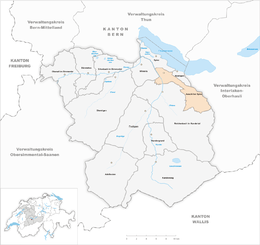Aeschi bei Spiez
| Aeschi bei Spiez | ||
|---|---|---|

Aeschi bei Spiez village
|
||
|
||
| Coordinates: 46°39′N 7°41′E / 46.650°N 7.683°ECoordinates: 46°39′N 7°41′E / 46.650°N 7.683°E | ||
| Country | Switzerland | |
| Canton | Bern | |
| District | Frutigen-Niedersimmental | |
| Government | ||
| • Mayor | Kurt von Känel | |
| Area | ||
| • Total | 30.99 km2 (11.97 sq mi) | |
| Elevation | 860 m (2,820 ft) | |
| Highest elevation | 1,400 m (4,600 ft) | |
| Lowest elevation | 850 m (2,790 ft) | |
| Population (Dec 2015) | ||
| • Total | 2,217 | |
| • Density | 72/km2 (190/sq mi) | |
| Postal code | 3703 | |
| SFOS number | 0562 | |
| Surrounded by | Krattigen, Lauterbrunnen, Leissigen, Reichenbach im Kandertal, Saxeten, Spiez, Wimmis | |
| Website |
www SFSO statistics |
|
Aeschi bei Spiez is a municipality in the Frutigen-Niedersimmental administrative district in the canton of Bern in Switzerland.
Aeschi bei Spiez is first mentioned in 1228 as Asshes. In 1269 it was mentioned as (villa) Esche..
The earliest traces of settlements in the area include scattered La Tene era graves and individual prehistoric tools. During the Middle Ages, it was part of the Herrschaft of Mülenen, under the Lords of Kien. The Herrschaft then passed through several other nobles, including the Wädenswil and Turn families. By the 13th century, Aeschi was the center of a large parish. The Romanesque parish church of St. Peter was first mentioned in 1228. The frescoes in the church were painted in the 14th century. In 1352, the city of Bern acquired the village land, while the low court rights remained with other noble families. Under Bernese rule, the village was initially part of the district of Mülenen. In the 15th and 16th centuries, it became part of Frutigen. The town charter was first documented in 1469.
In 1528, Bern forced the villagers to adopt the Protestant Reformation. In the following year, the parish was split and the village of Reichenbach became an independent parish.
During the 19th century the economy stagnated and the village population began to decrease. The rise of tourism the late 19th century allowed the population to begin to grow once again. In 1855, the Bad Heustrich medical spa opened in Aeschi. It soon grew into a well known resort and tourist destination. In 1901 the Lötschberg railroad allowed an increasing number of tourists to visit the village. A rail station opened in Mülenen in 1906. In the late 1960s the municipality experienced a building boom as the population grew and as demand for vacation homes rose. By 1990 almost two-thirds of the population worked in the services industry.
...
Wikipedia




